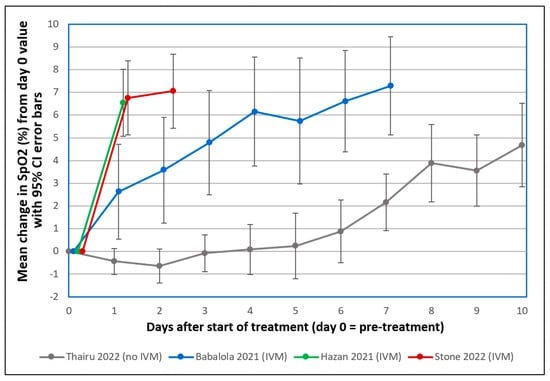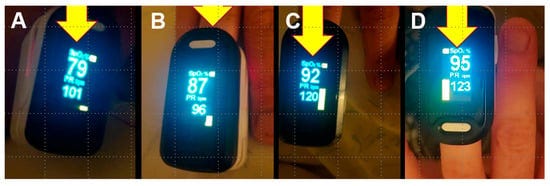Stone et al.: "Changes in SpO2 on Room Air for 34 Severe COVID-19 Patients after Ivermectin-Based Combination Treatment: 62% Normalization within 24 Hours"; These rapid increases in SpO2 values after
IVM treatment stand in sharp contrast to declines in SpO2 and associated pulmonary function through the second week following the onset of moderate or severe COVID-19 symptoms under standard care
SOURCE:
The emergence of COVID-19 in March 2020 challenged Zimbabwe to respond with limited medical facilities and therapeutic options. Based on early clinical indications of efficacy for the macrocyclic lactone, Ivermectin (IVM), against COVID-19, IVM-based combination treatments were deployed to treat it.
Oxygen saturation (SpO2) data were retrospectively analyzed for 34 severe, hypoxic COVID-19 patients all on room air (without supplemental oxygen). The patients, median age 56.5, were treated at clinics or at home between August 2020 and May 2021. All but three of these 34 patients had significantly increased SpO2 values within 24 h after the first IVM dose.
The mean increase in SpO2 as a percentage of full normalization to SpO2 = 97 was 55.1% at +12 h and 62.3% at +24 h after the first IVM dose (paired t-test, p < 0.0000001).
These results parallel similar sharp, rapid increases in SpO2, all on room air, for 24 mostly severe COVID-19 patients in the USA (California) who were given an IVM-based combination treatment.
All patients in both of these critical series recovered. These rapid increases in SpO2 values after IVM treatment stand in sharp contrast to declines in SpO2 and associated pulmonary function through the second week following the onset of moderate or severe COVID-19 symptoms under standard care.’
Figure 6. Mean changes in oxygen saturation (SpO2) for severe COVID-19 patients following treatments including or excluding IVM. Patients tracked over various time periods from each regimen were those with SpO2 values all recorded on room air, having pre-treatment (day 0) values ≤ 93%. The y axis value at day n is the mean of changes in SpO2 values from day 0 to day n, with error bars designating 95% confidence intervals. ● Thairu et al., 2022 [38,44]: 26 patients, median age 45, treated with varying combinations of lopinavir/ritonavir (Alluvia), remdesivir, azithromycin, and enoxaparin plus zinc sulfate and vitamin C. ● Babalola et al., 2021 [39,44]: 19 patients, median age 33, treated with IVM, zinc and vitamin C, with some also given azithromycin and hydroxychloroquine. ● Hazan et al., 2021 [45]: 19 patients, median age 63, treated with IVM, doxycycline and zinc. ● Stone et al., 2022 (this study): 34 patients, median age 56.5, treated with IVM, doxycycline and zinc, as described.
Figure 4. Changes in SpO2 over 3 h for a COVID-19 patient after administration of IVM. SpO2 values are shown (all on room air), with pulse rates (bpm) below those, at pre-treatment (A) and for 45 min (B), 90 min (C), and 3 h (D) after first dose of IVM. This patient, a 25-year-old male, was diagnosed with COVID-19 by a positive result from a rapid antigen test and treated with combination therapy including IVM, doxycycline, and zinc plus other oral and nebulized adjunct agents from among those itemized above.




Paxlovid is a money maker and a poor substitue for the cheap Ivermectin. Follow the money and you will discover who is pulling the strings!
IndIa IVM is very good and I can recommend it. Thank you for promoting this study Dr. Alexander. Amazing researchers and studies continue to counter the Big Lie from Big Pharma and Big Government!